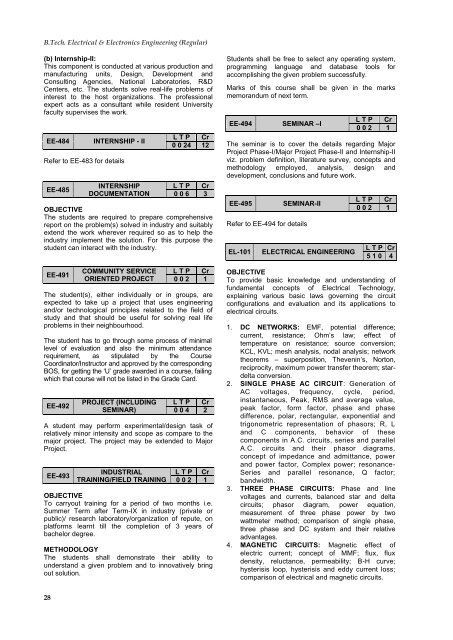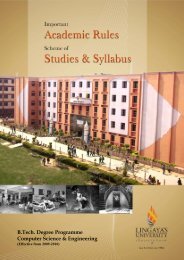B.Tech. <strong>Electrical</strong> & <strong>Electronics</strong> Engineering (Regular)(b) Internship-II:This component is conducted at various production <strong>and</strong>manufacturing units, Design, Development <strong>and</strong>Consulting Agencies, National Laboratories, R&DCenters, etc. The students solve real-life problems ofinterest to the host organizations. The professionalexpert acts as a consultant while resident <strong>University</strong>faculty supervises the work.EE-484INTERNSHIP - IIRefer to EE-483 for detailsEE-485INTERNSHIPDOCUMENTATIONL T P Cr0 0 24 12L T P Cr0 0 6 3OBJECTIVEThe students are required to prepare comprehensivereport on the problem(s) solved in industry <strong>and</strong> suitablyextend the work wherever required so as to help theindustry implement the solution. For this purpose thestudent can interact with the industry.EE-491COMMUNITY SERVICEORIENTED PROJECTL T P Cr0 0 2 1The student(s), either individually or in groups, areexpected to take up a project that uses engineering<strong>and</strong>/or technological principles related to the field ofstudy <strong>and</strong> that should be useful for solving real lifeproblems in their neighbourhood.The student has to go through some process of minimallevel of evaluation <strong>and</strong> also the minimum attendancerequirement, as stipulated by the CourseCoordinator/Instructor <strong>and</strong> approved by the correspondingBOS, for getting the ‗U‘ grade awarded in a course, failingwhich that course will not be listed in the Grade Card.EE-492PROJECT (INCLUDINGSEMINAR)L T P Cr0 0 4 2A student may perform experimental/design task ofrelatively minor intensity <strong>and</strong> scope as compare to themajor project. The project may be extended to MajorProject.EE-493INDUSTRIALTRAINING/FIELD TRAININGL T P Cr0 0 2 1OBJECTIVETo carryout training for a period of two months i.e.Summer Term after Term-IX in industry (private orpublic)/ research laboratory/organization of repute, onplatforms learnt till the completion of 3 years ofbachelor degree.METHODOLOGYThe students shall demonstrate their ability tounderst<strong>and</strong> a given problem <strong>and</strong> to innovatively bringout solution.Students shall be free to select any operating system,programming language <strong>and</strong> database tools foraccomplishing the given problem successfully.Marks of this course shall be given in the marksmemor<strong>and</strong>um of next term.EE-494 SEMINAR –IL T P Cr0 0 2 1The seminar is to cover the details regarding MajorProject Phase-I/Major Project Phase-II <strong>and</strong> Internship-IIviz. problem definition, literature survey, concepts <strong>and</strong>methodology employed, analysis, design <strong>and</strong>development, conclusions <strong>and</strong> future work.EE-495SEMINAR-IIRefer to EE-494 for detailsEL-101ELECTRICAL ENGINEERINGL T P Cr0 0 2 1L T P Cr5 1 0 4OBJECTIVETo provide basic knowledge <strong>and</strong> underst<strong>and</strong>ing offundamental concepts of <strong>Electrical</strong> Technology,explaining various basic laws governing the circuitconfigurations <strong>and</strong> evaluation <strong>and</strong> its applications toelectrical circuits.1. DC NETWORKS: EMF, potential difference;current, resistance; Ohm‘s law; effect oftemperature on resistance; source conversion;KCL, KVL; mesh analysis, nodal analysis; networktheorems – superposition, Thevenin‘s, Norton,reciprocity, maximum power transfer theorem; stardeltaconversion.2. SINGLE PHASE AC CIRCUIT: Generation ofAC voltages, frequency, cycle, period,instantaneous, Peak, RMS <strong>and</strong> average value,peak factor, form factor, phase <strong>and</strong> phasedifference, polar, rectangular, exponential <strong>and</strong>trigonometric representation of phasors; R, L<strong>and</strong> C components, behavior of thesecomponents in A.C. circuits, series <strong>and</strong> parallelA.C. circuits <strong>and</strong> their phasor diagrams,concept of impedance <strong>and</strong> admittance, power<strong>and</strong> power factor, Complex power; resonance-Series <strong>and</strong> parallel resonance, Q factor;b<strong>and</strong>width.3. THREE PHASE CIRCUITS: Phase <strong>and</strong> linevoltages <strong>and</strong> currents, balanced star <strong>and</strong> deltacircuits; phasor diagram, power equation,measurement of three phase power by twowattmeter method; comparison of single phase,three phase <strong>and</strong> DC system <strong>and</strong> their relativeadvantages.4. MAGNETIC CIRCUITS: Magnetic effect ofelectric current; concept of MMF; flux, fluxdensity, reluctance, permeability; B-H curve;hysterisis loop, hysterisis <strong>and</strong> eddy current loss;comparison of electrical <strong>and</strong> magnetic circuits.28
Lingaya’s <strong>University</strong>, Faridabad5. TRANSFORMER: Construction, principle, workingof ideal <strong>and</strong> practical transformer; equivalentcircuit, phasor diagram; OC <strong>and</strong> SC tests,regulation <strong>and</strong> efficiency; autotransformer.6. ROTATING ELECTRICAL MACHINES: DCMACHINES – construction, principle of operation<strong>and</strong> classification of dc machines, EMF equation<strong>and</strong> characteristics of dc generator, starting <strong>and</strong>speed control of dc motor.INDUCTION MACHINES: Construction <strong>and</strong>principle of operation of three phase inductionmotor, concept of slip <strong>and</strong> its importance.7. MEASURING INSTRUMENTS: Voltmeter;ammeter; wattmeter; energy meter.TEXT BOOKGupta, J.B. ―<strong>Electrical</strong> Technology‖, Katson PublicationREFERENCE BOOKS1. Theraja, B.L. ―<strong>Electrical</strong> Technology Vol I & II‖, S.Ch<strong>and</strong> Publications, 20052. Kothari <strong>and</strong> Nagarath, ―Basic <strong>Electrical</strong> Engg.‖, 2ndEdition, Tata McGraw Hill3. Theodore, Wildi ―<strong>Electrical</strong> Machines, Drives <strong>and</strong>Power Systems‖, 2nd Edition, Prentice Hall, 1991.4. Edward, Hughes (revised by Ian McKenzie Smith),―<strong>Electrical</strong> Technology‖, 7th Edition, EnglishLanguage Book Society, Publication withLongman, 1995.5. Del Torro Vincent, ―<strong>Electrical</strong> EngineeringFundamentals‖, 2nd Edition, Prentice Hall of India,1994.6. Cathey, J.J. <strong>and</strong> Naser, S.A. ―Basic <strong>Electrical</strong> Engg.‖,2nd Edition, Schaum Series, McGraw Hill Publ.EL-151ELECTRICAL ENGINEERINGLABL T P Cr0 0 2 1LIST OF EXPERIMENTS1. To verify KCL <strong>and</strong> KVL.2. To verify Thevenin‘s <strong>and</strong> Norton‘s Theorems.3. To verify maximum power transfer theorem in D.CCircuit <strong>and</strong> A.C Circuit.4. To verify Reciprocity <strong>and</strong> Superposition theorems.5. To study frequency response of a series R-L-Ccircuit <strong>and</strong> determine resonant frequency <strong>and</strong> Q-Factor for various Values of R, L, C.6. To study frequency response of a parallel R-L-Ccircuit <strong>and</strong> determine resonant frequency <strong>and</strong> Q-Factor for various values of R, L, C.7. To perform direct load test of a transformer <strong>and</strong>plot efficiency Vs load characteristic.8. To perform open circuit <strong>and</strong> short circuit tests on asingle-phase transformer determine the losses <strong>and</strong>efficiency.9. To perform direct load test of a DC shunt generator<strong>and</strong> plot load voltage Vs load current curve.10. To study various types of meters.11. Measurement of power by 3 voltmeter / 3 ammetermethod.12. Measurement of power in a 3 phase system by twowatt meter method.13. Connection <strong>and</strong> testing of a single-phase energymeter (unit power factor load only).REFERENCE BOOKS1. Theraja, B.L. ―<strong>Electrical</strong> Technology Vol I & II‖, S.Ch<strong>and</strong> Publications, 20052. Kothari <strong>and</strong> Nagarath, ―Basic <strong>Electrical</strong> Engg.‖, 2ndEdition, Tata McGraw Hill3. Del Torro Vincent, ―<strong>Electrical</strong> EngineeringFundamentals‖, 2nd Edition, Prentice Hall of India,1994.4. Cathey, J.J. <strong>and</strong> Naser, S.A. ―Basic <strong>Electrical</strong> Engg.‖,2nd Edition, Schaum Series, McGraw Hill Publ.EL-206ELECTRICAL MACHINES-IL T P Cr5 1 0 4OBJECTIVEProviding sound knowledge about the principles ofoperation of various electrical machines, theirconstructional features, <strong>and</strong> their behavior <strong>and</strong>characteristics under various condition of operation.PRE-REQUISITESBasic of knowledge of <strong>Electrical</strong> Technology <strong>and</strong> Circuits.1. INTRODUCTION TO ELECTRO-MECHANICALENERGY CONVERSION: Basic principles,concept <strong>and</strong> laws of magnetic circuits; energy insingle <strong>and</strong> multiple excited magnetic systems;basic differential equations of electromechanicalenergy conversion devices; equations for force <strong>and</strong>torque in single <strong>and</strong> multiple excited magneticsystems; reluctance torque.2. SINGLE PHASE TRANSFORMERS: Basic principle;basic theory of an ideal transformer; construction oftransformers i.e. core, winding, tank, conservator,Breather, cooling methods, buchholz relay; equivalentcircuit; phase diagram; per unit representation ofparameters; regulation; losses <strong>and</strong> efficiency;transformer tests i.e. open circuit, short ckt. <strong>and</strong>sumpner‘s test; separation of iron losses; nature ofmagnetizing circuit; plotting of B – H curve; inrushcurrent; harmonics; parallel operation of 1 –Φtransformer <strong>and</strong> load sharing; auto transformer:Principle; construction; comparison with 2 – windingtransformer; application of autotransformer.3. THREE PHASE TRANSFORMER: Construction ofthree winding transformer; various types ofconnections; their comparative features; zig-zagconnection; phase conversion - 3Φ to 1Φ; 3Φ to2Φ; 3Φ to 6Φ <strong>and</strong> 3Φ to 12Φ.4. SPECIAL TYPE TRANSFORMERS: Tap changingtransformer; phase shifting transformer; pulsetransformer; isolation transformer; weldingtransformer; rectifier transformer; high frequencytransformer.5. D.C. GENERATORS: Elementary DC machine;emf equation; Principle <strong>and</strong> construction of D. C.Generator; lap <strong>and</strong> wave winding; methods ofExcitation of D. C. Generators; Armature Reaction;Commutation in D. C. Machines; Compensatingwindings; characteristics of D. C. Generators;Parallel operation of Generators.29
















